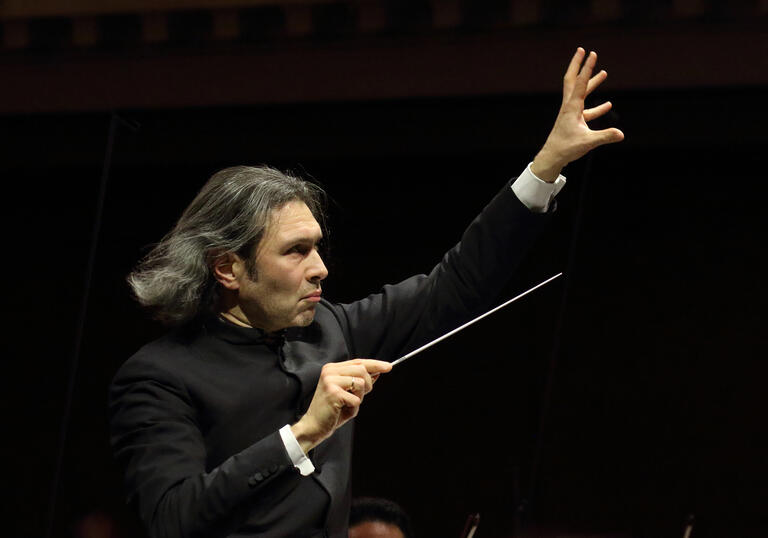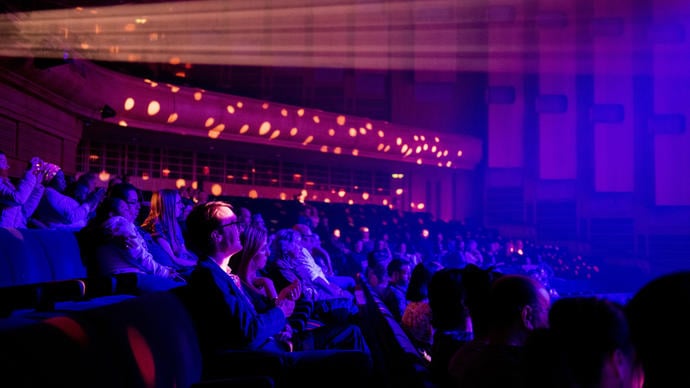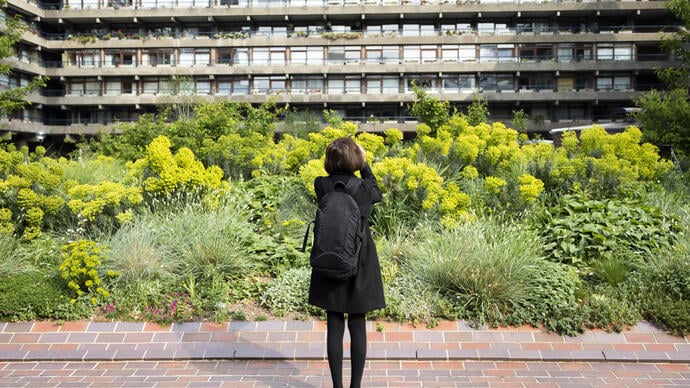Bayerisches Staatsorchester/Jurowski: Alpine Symphony

In the first of two concerts Vladimir Jurowski directs the Bayerisches Staatsorchester – which is celebrating its 500th birthday – in a claustrophobic vision of snow, an elegiac 20th-century violin concerto and a mighty Alpine tone-poem.
Humanity’s rich and complex relationship with nature is a theme that threads its way through this programme. Immersion in the natural world may elicit strangely contradictory emotions: a sense of our insignificance in its vastness; an awareness of mortality when the forces of nature are pitted against us; a sense of pride in ‘conquering’ the apparently unconquerable.
Ukrainian composer Victoria Poleva regularly addresses these themes in her scores. Her single-movement White Interment was composed in 2002 for oboe and strings before she arranged it for full orchestra, turning it into her Third Symphony. The work is founded on the rhythm of the words ‘teper’ vsegda snega’, meaning ‘now always snow’, and evokes the sense of being trapped in an icy prison: drawn into a blizzard, buried beneath a snowdrift, succumbing to sleep as the surrounding space implodes. These claustrophobic impressions are conjured by Poleva using static effects designed to provoke an almost psychedelic response in the listener. Blocks of sounds are structured using classical allusions, including circulatio (the Latin for ‘circle’), a whirling melody that evokes the infinity sign; catabasis (the Greek for ‘descent’), represented by a falling shape; the ascending anabasis (the Greek for ‘climbing’); and aposiopesis (the Greek for ‘concealment’ or ‘disguise’), reflected by a general pause depicting death and eternity.
Death and eternity were at the forefront of Alban Berg’s mind as he composed his Violin Concerto. The work was commissioned in 1935 by Ukrainian-American violinist Louis Krasner; soon afterwards, Manon Gropius, the 18-year-old daughter of Alma Mahler and her second husband Walter Gropius, died of polio. Berg was distraught and quickly composed the concerto in tribute, dedicating it ‘to the memory of an angel’. Other figures inhabit the score: Berg’s enduring affair with Hanna Fuchs-Robettin is represented by the notated equivalents of their initials, and a reference to a Carinthian folksong A Bird in the Plum Tree hints at an earlier dalliance with a woman on the staff of his family’s summer residence in Carinthia. These elements soften the effect of the 12-tone serial procedures used by Berg in the work, based on a system pioneered by his teacher and fellow member of the Second Viennese School, Arnold Schoenberg. Other tonal allusions include a quotation of J S Bach’s funereal chorale ‘Es ist genug’ from his Cantata BWV60 – the text of which describes a soul’s journey from earth to heaven.
Whereas Berg included hidden programmes in other works, the message of this score was explicitly described by him to his first biographer Willi Reich. It is written in two movements, both of which are in two sections: the first movement portrays Manon, the second her illness and death. Berg’s annotations on the score mention ‘cries’ and ‘groans’; tragically, it was to become his own requiem, as he died not long after finishing the score and didn’t live to hear it performed.
Strauss was working on his Alpine Symphony when he learned of the death of Mahler in 1911. He wrote in his notebook: ‘the German nation will achieve new creative energy only by liberating itself from Christianity … I shall call my alpine symphony: Der Antichrist, since it represents: moral purification through one’s own strength, liberation through work, adoration of eternal, magnificent nature’. These ideals recall Friedrich Nietzsche, and musically there are also nods to Strauss’s Nietzschean tone-poem Also sprach Zarathustra. In the end, Strauss rejected the ‘Antichrist’ idea in favour of a celebration of Nature.
The scoring of the Alpine Symphony was completed on 8 February 1915, and Strauss dedicated the work ‘in profound gratitude’ to Count Seebach, director of Dresden’s Royal Opera House, where several of his operas had been premiered. The premiere was given on 28 October in Berlin by the Dresden Court Orchestra under the composer’s direction. At the final rehearsal Strauss observed: ‘At last I have learned to orchestrate. I wanted to compose, for once, as a cow gives milk.’
The scale of the Alpine Symphony is unparalleled in the composer’s output, calling for an orchestra of over 140 players including eight horns, 12 offstage horns, wind and thunder machines, cowbells, celesta, quadruple woodwind and organ. The work portrays 24 hours in the mountains through a series of tableaux. The sense of place is vivid, with Mahlerian cowbells leaving us in no doubt as to the setting; and the music exudes a pastoral grandeur reminiscent of Bruckner’s Alpine evocations. The opening, recalled at the end, is particularly striking, involving a descending succession of sustained pitches built up until every degree of the scale is heard simultaneously. But although Strauss lived in the Alpine town of Garmisch for over three decades, it seems this ambitious and exhaustive account of the Alps was all he needed to say on the subject. Apart from quoting the Alpine Symphony in a couple of songs, he never again attempted so specific a tribute to the spectacular beauty of his surroundings.
© Joanna Wyld
Details
Programme and performers
Victoria Poleva White Interment (UK premiere)
Alban Berg Violin Concerto
1. Andante
2. Allegro
Richard Strauss Eine Alpensinfonie
Night – Sunrise – The ascent – Entering the forest – Wandering by the brook – At the waterfall – Apparition – On the flowery meadows – On the mountain pasture – Lost in thickets and undergrowth – On the glacier – Precarious moments – On the summit – Vision – Mists rise – The sun is gradually obscured – Elegy – Calm before the storm – Thunderstorm, descent – Sunset – Epilogue – Night
Bayerisches Staatsorchester
Vladimir Jurowski conductor
Vilde Frang violin
Artist biographies
The Bayerisches Staatsorchester this year celebrates its 500th birthday, making it one of the oldest orchestras in the world, rich in tradition. As the in-house ensemble of the Bayerische Staatsoper, the musicians feel at home both in the orchestra pit and on stage.
In 2022 it was voted Orchestra of the Year for the eighth consecutive year by opera critics in Opernwelt magazine. The same year it won the opera and orchestral categories at the Gramophone Awards, with Korngold’s Die tote Stadt additionally being voted Record of the Year.
The Bayerisches Staatsorchester began life as the Munich court orchestra. Its origins can be traced back to the year 1523. The ensemble’s first well-known director was Orlando di Lasso from 1563. While the focus of its artistic expression consisted initially of church music, as the 17th century progressed more mainstream concerts and opera performances were added to their repertoire. By the mid-18th century, operas were being performed more regularly and today constitute one of the orchestra’s principal focuses. The world premieres of Mozart’s La finta giardiniera (1775) and Idomeneo (1781) were early milestones.
In 1811 the members of the court orchestra founded the Musical Academy which hosted Munich’s first ever public concert series, the academy concerts. Here, the Munich audience were introduced to musicians such as Clara Schumann, Johannes Brahms and Edvard Grieg. Today, the Musical Academy continues to influence the cultural life of the city and the state of Bavaria. Alongside symphonic concerts at the Nationaltheater and a variety of chamber music series, the academy is also home to the ATTACCA youth orchestra and the Hermann Levi Academy which are committed to supporting and training musicians at the start of their careers. Through the company Bayerisches Staatsorchester Konzert GmbH the Musical Academy organises and manages its orchestra tours and symphonic guest performances itself. These regularly take the orchestra to the music capitals of the Europe, including Berlin, Hamburg, Frankfurt, Milan, Paris, Vienna, Lucerne and London, as well as further afield to Tokyo, Seoul, Taipei and New York.
Among the many great composers with whom the orchestra have been affiliated, Richard Wagner is prominent. In 1865 Hans von Bülow conducted the world premiere of Tristan und Isolde at the Nationaltheater. Three further Wagner operas were also premiered in Munich: Die Meistersinger von Nürnberg (1868), Das Rheingold (1869) and Die Walküre (1870).
The orchestra has had a distinguished roster of chief conductors, from Richard Strauss, Hermann Levi, Felix Mottl, Bruno Walter and Hans Knappertsbusch to Georg Solti, Joseph Keilberth, Wolfgang Sawallisch, Zubin Mehta, Kent Nagano and Kirill Petrenko. The orchestra also enjoyed a close relationship with Carlos Kleiber. Vladimir Jurowski became General Music Director of the Bayerisches Staatsorchester in the 2021/22 season.
Vladimir Jurowski was born in Moscow and began his musical training at the Moscow Conservatory, later studying in Berlin and Dresden. He made his international debut as an opera conductor with Rimsky-Korsakov’s May Night at the 1995 Wexford Festival. Later that same season he appeared for the first time at the Royal Opera House, Covent Garden, conducting Verdi’s Nabucco. Since then he has appeared at leading venues, including New York’s Metropolitan Opera, La Scala, Milan, the Paris Opéra, Moscow’s Bolshoi Theatre, Dresden State Opera and the Salzburg Festival.
Between 1997 and 2001 he was Principal Conductor at the Komische Oper in Berlin and from 2001 to 2013 was Music Director of Glyndebourne. Between 2007 and 2021 he was Principal Conductor of the London Philharmonic Orchestra, where he retains the title of Conductor Emeritus. Since 2017 he has also been Principal Conductor and Artistic Director of the Berlin Radio Symphony Orchestra and is additionally Principal Artist of the Orchestra of the Age of Enlightenment. Until 2021 he was Artistic Director of both the International George Enescu Festival in Bucharest and the Yevgeny Svetlanov State Academic Symphony Orchestra of Russia. He works regularly with the Chamber Orchestra of Europe and the ensemble unitedberlin.
As a guest conductor he has appeared with the Berlin, New York and Vienna Philharmonic orchestras, Leipzig Gewandhaus Orchestra, Dresden Staatskapelle, Zurich Tonhalle Orchestra, Royal Concertgebouw Orchestra, Boston and Chicago Symphony orchestras, Cleveland Orchestra and the Philadelphia Orchestra.
He made his debut at the Bayerische Staatsoper in 2015, conducting an Academy Concert whose programme included Prokofiev’s Third Symphony, before going on to conduct a new production of the same composer’s opera The Fiery Angel in the November of that year. He also conducted a new production of Der Rosenkavalier during the 2020/21 season. Since 2021 Vladimir Jurowski has been the General Music Director of the Bayerische Staatsoper.
Norwegian violinist Vilde Frang was born in Oslo and studied the violin at the city’s Barratt Due Institute of Music and with Kolja Blacher at Hamburg’s University of Music and Theatre. She also received help and encouragement from Ana Chumachenco at the Kronberg Academy. She was aged just 12 when Mariss Jansons invited her to appear as a soloist with the Oslo Philharmonic.
A scholarship from the Friends of the Anne-Sophie Mutter Foundation allowed her to start out on an international career at an early age. Important debuts include those with the Vienna Philharmonic under Bernard Haitink at the 2012 Lucerne Festival and with the Berlin Philharmonic under Sir Simon Rattle in 2016. She has since performed with many other leading orchestras, including the Leipzig Gewandhaus Orchestra, Dresden Staatskapelle, Deutsches Symphonie-Orchester Berlin, Bavarian Radio, BBC, City of Birmingham, London and San Francisco Symphony orchestras, Zurich Tonhalle Orchestra, Royal Concertgebouw Orchestra, Orchestre de Paris, Orchestre Philharmonique de Radio France, Mahler Chamber Orchestra, Los Angeles and Liverpool Philharmonic orchestras, Cleveland Orchestra and the Pittsburgh Orchestra at the Mostly Mozart Festival at New York’s Lincoln Center.
As well as working with Rattle, Jansons and Haitink, she has also appeared with Herbert Blomstedt, Esa-Pekka Salonen, Vladimir Ashkenazy, Iván Fischer, Sakari Oramo, Jakub Hrůša, Vladimir Jurowski, Manfred Honeck, Mirga Gražinytė-Tyla, Daniel Harding, Semyon Bychkov, David Zinman, Sir Antonio Pappano, Lahav Shani, Paavo Järvi and Yuri Temirkanov.
She plays a 1734 Guarneri del Gesù violin, on loan to her. She made her debut with the Bayerisches Staatsorchester in 2019 playing Korngold’s Violin Concerto, following this up earlier this year with Mendelssohn’s Violin Concerto in E minor; tonight’s performance of the Berg concerto is part of a tour with the orchestra.

Our Patrons and supporters
Find out about our Patrons, who help us keep our programme accessible to everyone and allow us to continue investing in the artists and communities we work with.
Love the arts? Become a Patron to engage more closely with our programme.

Who we are
Meet our management team, our Board and the Trustees of our charitable arm, Barbican Centre Trust.
